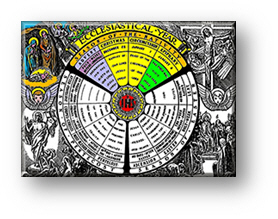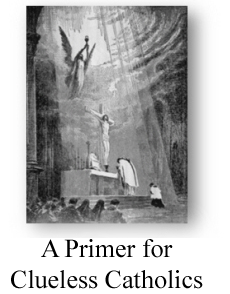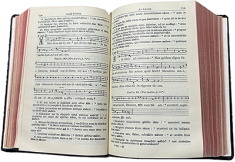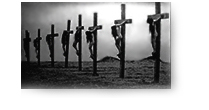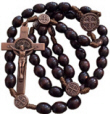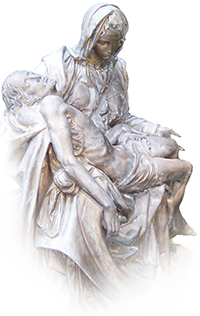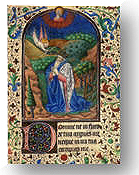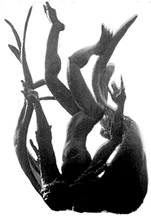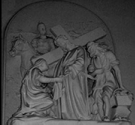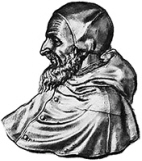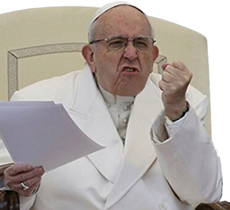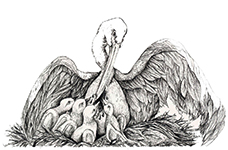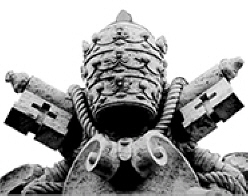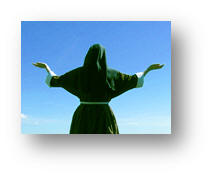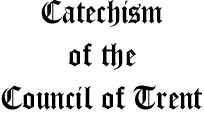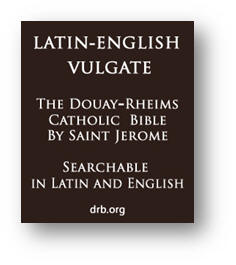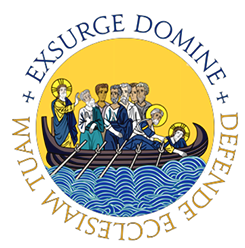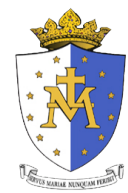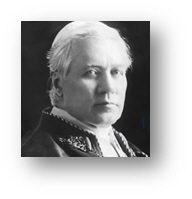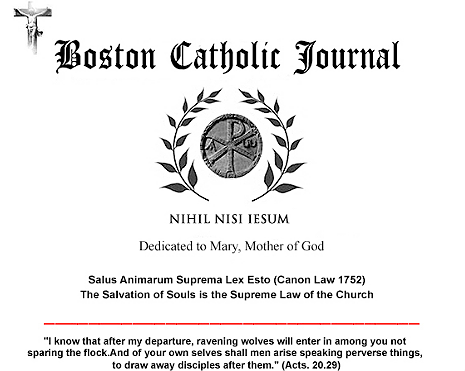
CRITICAL CATHOLIC COMMENTARY
in the Twilight of Reason
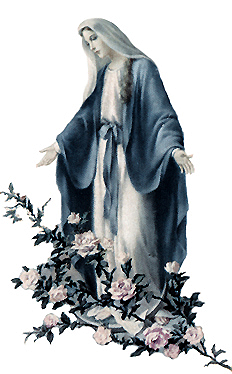
Mary, Conceived without
Sin,
pray for us who have
recourse to Thee
Easter Saturday
Infidelis villicus mortuus est.
Deus misereatur eius.
The Unfaithful Steward is dead.
May God have mercy on him.
I say
this with neither malice nor
satisfaction. I do not rejoice
in the death of any man —
especially a man whom the world
loved.
And why
is this?
Because
I recall the words of Christ Himself in the Gospel
of Saint John:
“If you had been of the
world, the world would love its own: but because you
are not of the world, but I have chosen you out of
the world, therefore the world hateth you.” (St.
John 15.19)
Francis
was loved by the world.
One
cannot be on good terms with the world and with God.
Christ
was not.
All His
best friends were not: the holy Saints and Martyrs.
Were
they loved by the world?
They
were crucified by the world; fed to
wild beasts, decapitated, drawn and quartered,
eviscerated, hanged, burned alive. There is nothing too cruel
for the world to graphically demonstrate its utter
malevolence toward those whom Christ
loves most.
Reflecting on this, it is, I think, noteworthy that
Francis was especially loved by those deeply
antagonistic to the Catholic Church and what she
authentically teaches (and I hasten to add, not
what some of her sons ideologically distort her
teaching to be): the media, especially the legacy
media, political, public, and entertainment figures
that have known and bitter disagreements with the
Catholic Church — to say nothing of groups
vehemently opposed to the Catholic Church’s teaching
on life and sexual morality such as feminists and homosexual activists who had been
well received by Francis in a way that he would not
extend, for example, to the persecuted Cardinal Zen
of China.
Such
inconsistencies do not and will not leave a kind
legacy for Francis. Despotic, crude, and
self-aggrandizing (he had written two
autobiographies
while
no other pope in history had ever written
one), he will not be missed despite the obligatory
appearances of mourning now that the pall of
fear has dissipated from Sanctae Marthae.
As I
have said
elsewhere, Francis was an Unfaithful Steward who
in the Master’s absence, tossed away the Key given
Him, seized the House, and imagining it his own, did
with it as he willed, mistreating the
servants. And we all remember the ending to that
parable, yes?
Geoffrey K. Mondello
Editor
Boston Catholic Journal
Comments? Write us:
editor@boston-catholic-journal.com
Monday April 21, 2025
Feast of St. Anselm,
bishop and Doctor of the Church

No Longer Listening …
Why Did it
Take This Long?
Since
Francis fell into manifest heresy
long ago, I no longer entertain anything that he
says with the least bit of interest — simply because
it has become, not merely stultifying and tiresome,
but routinely an affront to reason itself. I am no
longer listening.
Why did it take this long? I am
without excuse.
Emancipation
Bergoglio’s inability
to present even his shallow theological novelties in
terms rationally compelling (were that even
possible) rather than relying on meaningless
emotional pathos and fatuous appeals to artificial
abstractions … and failing that, (and most often) on
brute and often uncouth force … no longer perplex
me, or trouble me. I have come to a point of blithe
discourtesy concerning Bergoglio, because nothing
less will compel me to be absolutely blunt … and I
feel that I must be blunt to explain my
sudden emancipation from my remotest concern for
anything Bergoglio has to say or could possibly say.
It is, in a word, drivel.
All of it.
I will come to the
point: Jorge is a thug posing as a dilettante. Age
is no excuse for the malice he has for Catholics who
embrace a Faith that he has long lost or never had.
In this sense, Jorge is an imposter. Whatever terms
you apply to him, none of them are good. He is
sanctimonious and utterly disingenuous: the vulgar
and arrogant persona
encountered by those unfortunate enough to be
subjected to his presence behind closed doors in
Sancta Martha could not be farther from the
contrived and unctuous
personality encountered by public — this is well
known — and because his agenda coincides with that
of the secular world, the media slavers and lavishes
him with praise. They know he is one of them.
But he
is not one of us.
The
Monster and Momus ... or the Monster Momus?
Francis, in a word, is
a monster. And as we all know from the movies, even
the greatest monsters die in the end. Whether or
not, like many a monster, he perishes in the
ignem aeternum of St. Matthew 18.8, is not, of
course, ours to know and in charity we must pray
against it. But given his own contemptuous funeral
arrangements calculated to mock every pope before
him, perhaps Jorge’s best cognomen would be “the
Mocker” … of everything good, true, beautiful, and
holy. Within that pantheon of pagan gods that he
daily recognizes and
prays to, we must now find the demigod Momus, the Mocker,
who has ever been a thorn in the heart of Rome and
now sits as a travesty in the seat of Saint Peter.
Geoffrey K. Mondello
Editor
Boston Catholic Journal
 Printable PDF Version
Printable PDF Version
Comments? Write us:
editor@boston-catholic-journal.com
(This article was revised on April 13, 2025 Palm
Sunday)
The Most Urgent Question of Our Time
“When the Son of Man
Comes, will He Find Faith on Earth?”
(St. Luke
18.8)
No more stunning, no more
frightening, and perhaps no more ominously portentous words
are spoken in all the Gospels, in fact, in the entire New
Testament — perhaps even in the entirety of Sacred Scripture
itself; words that have become increasingly fraught with
significance with every passing year of the most unfortunate
papacy of Francis — a papacy not just likely … but I
believe with certainty … will be understood not simply as
among the worst … but the worst … the most destructive to
the Faith and to the Church in the annals of 2000 years of
Church history.
Indeed, with every generation following that devastating
Second Vatican Council — that scorched earth assault on
Tradition and historical Catholicism — the question
increasingly verges on an implied and obvious answer.
Indeed, we must wonder if the question that Christ poses …
“When the Son of Man comes will He find Faith on earth?” …
is, in fact, spoken of this generation, or of one soon —
very soon, to come.
As with so many of Christ’s teachings, this troubling
question is too often and too deftly explained away —
especially by the overwhelming number of the liberal
theologians and bishops who have proliferated and multiplied
since 1962 — which is to say, by “the
learned and the wise”. If we heed them, it would
appear that either Christ does not know what He is
saying, or we do not know what He is saying —
although we all agree that He said something ... that
sounds suspiciously clear.
We must, however, pay careful attention to these twelve
words, …. perhaps more now than at any
other time in Church history.
“When the Son of Man comes will He find
Faith on earth?”
These are twelve words, however, to which we must pay
careful attention, perhaps more now than at any other time
in Church history.
However reluctant we are to take Christ at His word — which
becomes increasingly inconvenient to us — we must recognize
that Jesus never spoke idly: His words, His teachings — and
yes, His Commandments — were always uttered to one
explicit end: the salvation of souls — attaining to Heaven
and everlasting happiness and to avoiding Hell and eternal
misery.
The Jewish religious authorities —
“the learned” of His own time — had scornfully
dismissed Christ’s warning that not so much as stone would
remain standing in the great Temple 1
... the very Temple within which, 70 years later, these
words were fulfilled when Rome laid waste in days what took
46 years to build.
We tend to view such alarming statements made by Jesus — and
there are many — with the same scorn and disdain today.
Indeed ... what has become of the “Faith of our Fathers?”
A mere fifty years ago we ourselves would have instinctively
replied “Of course He will find faith! There simply
must be some deeper, some obscure and less evident meaning
to this that we do not presently understand — and what He
appears to be saying, He is not really saying at all.
Surely the “learned” of our own day can deftly explain the
answer to this troubling question. In the end, they will
conclude, Jesus is really asking something entirely
different from what He appears to be asking and
that it has nothing to do with our very real defection from
the Faith.”
It is likely that many Jews of Jesus’ time — both the
learned and the unlearned — had replied in much the same
way. In fact, they did. 2
In other words, to us, our faith, the Faith of the Catholic
Church for two millennia, could no sooner disappear than ...
well, the stones of the great Temple 2000 years ago!
If, however, we take a careful inventory of our present and
undeniably dismal and increasingly scandalous situation in
the Church — especially as it has unfolded in the last five
decades — Jesus does not quite appear as ... “perplexing”
... as so many apparently make Him to be.
Candidly Ask yourself the following:
Has the Faith — the Catholic Faith — flourished in
the last 50 years, or has it withered?
Are vocations to the Priesthood and Religious life
growing or dwindling?
Are Catholics having more children or are they having
fewer children?
Are Missionary efforts, to the end of (dare we say
it?) “conversion” as mandated by Christ
2 encouraged as intrinsic to Catholicism
— or are they discouraged as impolite, obtrusive,
culturally imperialistic and inherently inimical to the
“Ecumenical spirit of Vatican II” — especially as
interpreted by Pope Francis for whom “proselytism is solemn
nonsense,” to use his own words, words that mock the
sacrifices of countless missionary saints through the 2000
years preceding Vatican II’s
“more
enlightened” understanding of the
Great Commission*?
Rather, we find that “conversion” to Christ and His Church
is actively discouraged — that especially under Pope
Francis it is no longer understood as a holy and
inherently necessary endeavor — instead, it is
disdained, even dismissed, as “socially and culturally
incorrect” — indeed, we find that promoting our
Catholic Faith — as Christ has commanded us to— has
been forbidden by Francis and his “progressive”
coterie of feckless and disaffected cardinals and bishops!
What pope, prior to Vatican II, could ever have envisioned
this?
Is our understanding of the Catholic Church, as an
absolutely unique institution indispensable to the ordinary
means of salvation, emphasized as urgently today (if it
is emphasized at all) as it was a hundred years ago? Fifty
years ago? Indeed, is the concept itself — of the
singularity and indispensability of the Holy Catholic Church
— still deemed an actual dogma and a viable concept
at all?
For all our insolence and equivocation, we know the answers,
and we are uncomfortable with them, for they fly in the face
of Christ and all that He taught — to say nothing of Sacred
Scripture, Holy Tradition, and the Sacred Deposit of the
Faith entrusted to the Catholic Church by God Himself.
Indeed, Christ’s question takes on a greater sense of
urgency still, for the sheep are scattered and confused as
never before. The papacy of Francis has been disastrous for
the Church. Why? Precisely because he has taken Vatican II
to its logical conclusion: the irrelevance of the
Church.
Ubi est Pastor?
Where is the Shepherd? Who is earnestly addressing
this spiritual malaise and religious decay due to the
indolence and dereliction of the vast majority of American
and European bishops who appear far more eager for secular
plaudits than the now quaint and discredited notion of “the
salvation of souls.” Pope Francis has effectively declared
this mandate defunct in favor of the rehabilitation of
bodies, societies, economies, and “the environment”. That
the passing material environment of man is infinitely
less important than the eternal abode of his soul,
often appears to elude Francis. Indeed, it appears to elude
most Catholics whose mantra increasingly coincides with the
world’s: Social activism! ... not interior
conversion away from this world ... and to Christ.
Shame! Shame on us! By our silence, our fear of being
disparaged by “other Catholics” for the sake of Christ, we
condone this travesty — are complicit in it ... even
promote it!
What will motivate us to recognize, and to redress,
this frightful and ultimately deadly state of affairs?
There are, after all, other contenders in this world for the
souls of men ... seen and unseen! As our own wick smolders,
others blaze! The burning Crescent of Islam, poised like a
scimitar, and every bit as deadly, glows and grows in the
east, and with it, not an ethnic, but a Religious
Cleansing to which the world remains indifferent — an
expunging of every vestige of Christianity in partibus
infidelium. And even Islam has its secular
collaborators: the European Union — once a continent raised
up from utter barbarism to a civilization formed and
ennobled by its Catholic heritage — will no longer tolerate
the inclusion of its indissoluble Christian heritage within
its Constitution. Not only does it thoroughly repudiate its
own Christian cultural heritage — it prohibits it —
even banishes it! This is nothing less than
self-loathing. And perhaps it ought to be.
Surely, then, in our effort to remedy this impending state
of dissolution, we will first turn to our bishops, since
they are, preeminently, the “Teachers and Guardians of the
Faith”. But more often than not — much more often than not —
in the well-appointed office at the end of the corridor we
do not find a shepherd of souls but a deeply sequestered,
occasionally avuncular, and predictably remote ...
“administrator.”
Relegating his prime responsibility as Teacher and Promoter
of the Faith ... to others, in the form of Lay committees
and subcommittees largely “chaired” by liberal Catholics
more concerned with social issues than the salvation of
souls, are we confident that the patrimony of our faith will
somehow percolate through this strata of already
contaminated soil and reach our children authentically and
intact? Is our fear mitigated ... or further exacerbated ...
by our bishops’ resolute lack of diligence in being
attentive to what Catholic colleges and theologians in their
own dioceses are really teaching — and who are teaching the
teachers ... who, in turn, are teaching our children?
Do you think that your bishop actually — that is to say,
cognitively — is aware of, or even concerned with — what the
teachers themselves are actually teaching?
Not in this diocese. Not in Boston. In fact, Cardinal Sean
Patrick O’Malley had routinely feted, praised, and held up
as exemplary, the clueless “Catechists” who churn out our
children to the Sacrament of Confirmation — with no clue
whatever of that in which they are being confirmed. By
comparison, even the dismal failure of our public schools in
Boston must be deemed a stunning success.
For most of us — especially in the Archdiocese of Boston,
but no less elsewhere — the answer is, as they say, a
“no-brainer:” it is a universally resounding no. Most
of us find, to our growing dismay and deepening cynicism,
that our bishops appear to have “more important,” more ...
“pressing” things to do ... than to communicate the Faith to
the faithful ... especially the children.
Really, we beg the question: if no one teaches the teachers
— who, then, teaches the children? If they are not brought
the faith by those to whom it has been entrusted — the
bishops, the episcopacy — who will bring it to them?
Will they — how can they — acquire the Faith ... if
no one brings it to them? Saint Paul is very clear about
this:
“How then shall they call on him,
in whom they have not believed? Or how shall they
believe him, of whom they have not heard? And how shall
they hear, without a preacher? And how shall they preach
unless they be sent ...?” (Romans 10.14-15)
Ask yourself candidly: do you know more ... or less ... of
your Catholic faith than your children? Very likely more —
although, in all honesty, it is probably little. You
politely assent to the now quaint Catholic notion that
“parents are the primary teachers of their children,” but
knowing little of your own Faith, you simply shell out
$175.00 per child and pan off this grave responsibility to
others of whom you know nothing, and who themselves largely
know nothing of the faith they presume to teach. You go
through the motions as careless of what your children are
taught in their 10 years of “Religious Education” as your
bishop is of what the teachers teach. 10 years later, and
$1500 poorer per child, you scratch your head and wonder why
Johnny still does not know God, and why Judy never goes to
Mass — and yet we have agreed that you know more than your
children ...
What, then, we must ask — with growing apprehension — will
your children teach their children ...?
What will they — who know even less than you —
teach those who know nothing?
Total Ignorance
The momentum, as we see, is inexorable — until it culminates
in total ignorance: every generation knows less of their
faith than the generation preceding it. It is, in the end,
the devolution from doctrine to legend, from legend to
fiction, and from fiction to myth.
That is not just a poor, but a stultifying and ultimately
deadly patrimony.
This default — at every level — in transmitting the
authentic Catholic faith intact ... leaves Jesus’
question very suddenly very real.
“Recently, a Gallup poll was taken on Catholic attitudes
toward Holy Communion. The poll showed serious confusion
among Catholics about one of the most basic beliefs of
the Church. Only 30 percent of those surveyed believe
they are actually receiving the Body and Blood, soul and
divinity of the Lord Jesus Christ under the appearance
of bread and wine.” 4
The problem is more than mathematical; as we have seen, it
is exponential. 70% of Catholics do not possess this most
fundamental, this most essential understanding of the core
article of genuine Catholic doctrine: that
“Unless you eat of the flesh of the
Son of Man, and drink His Blood, you have no life in you.”
Heavy stuff!
It is not just a matter of the greatest concern, but nothing
less than a matter of the gravest dereliction that most
Catholics do not realize — do not know — that the very
Mass itself is an abbreviation of “The Most Holy
Sacrifice of the Mass”, and that it is really a Sacrifice,
the actual re-enactment of Calvary before their very eyes!
This failure of understanding ... culminates in a failure in
Faith. It possesses, in significant ways, the remorseless
characteristics of mathematical certainties. Not
understanding, grasping — having never been taught — the
most elementary features of the faith, how can they be
understood to possess what they have not acquired, and how
can they transmit, pass on, what they do not possess? It is
inescapable.
Prognostication, of course, is for fools.
But the words of Christ are certainties that will come to
pass.
“Weep not for Me, but for your
children”, 5 Christ
told the sorrowing women on the road to Calvary.
Jesus’ question, then — “When the Son
of Man comes will He find faith on earth?”— is
not a “rhetorical question” at all; it is a question fraught
with enormous significance ... the frightful answer
to which appears to be unfolding before our very eyes ...
but that is if you take Christ at His word — and given
Jesus’ track record on things yet to come, we would do well
and wisely to give pause for more than thought.
Are you worried now ...? Not nearly enough.
And this is all the more frightening still.
Geoffrey K. Mondello
Editor
Boston Catholic Journal
Comments? Write us:
editor@boston-catholic-journal.com
_____________________________________________
1 St. Matthew 24.1
2
St. John 2.19
3
St. Matthew 28:19
4
https://www.catholicculture.org/docs/doc_view.cfm?recnum=1340
5
St. Luke 23.28
*
“Going
therefore, teach ye all nations; baptizing them in
the name of the Father, and of the Son, and of the
Holy Ghost. Teaching them to observe all things
whatsoever I have commanded you: and behold I am
with you all days, even to the consummation of the
world.”
(St. Matthew 28.19-20)
Concerning
the graphic:
“And
I saw, when he had opened the sixth seal, and behold
there was a great earthquake, and the sun became
black as sackcloth of hair: and the whole moon
became as blood: And the stars from heaven fell upon
the earth,”
(Apocalypse 6.12-13) and
“The
sun shall be turned into darkness, and the moon into
blood: before the great and dreadful day of the Lord
doth come.”
(Joel 2.31)
 Printable PDF Version
Printable PDF Version
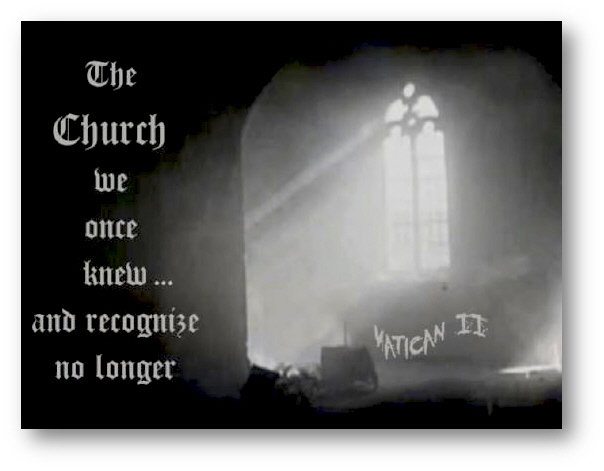
On The Imminent Passing of the
Catholic Church
From All Memory
(updated Sunday October 6, 2024)
The
despotic and heretical reign of Pope Francis will end.
It was a papacy unlike any other, for we found in the
Seat of Peter the erstwhile unimaginable ... a heretic.
Not a promoter of the Faith, but a destroyer of the
Faith. A man whose gods were many and whose
scruples were few; who seized the House of the Master
and pretended it was his own, throwing down the walls
that the martyrs built and bled upon; clearing the Altar
for strange new gods. He was ever a grievous wound in the side of the Church, and
like all healthy bodies, the Body of Christ, which is
the Church, developed a hard and ugly response to it.
As a scab that has
been pulled off a wound, leaving it painful and bleeding
once again ... but beginning to heal ... the ill-starred
papacy of Francis, once it has been peeled away from the
unblemished Body, will begin to allow the healing so
desperately needed in a deeply infected body.
But it is almost
equally certain that the return to a state of health will be painfully long. The Church will not
soon recover from the horrific damage inflicted upon it
by Francis. The foreign pathogens and deadly toxins that
he inserted deeply into the body will not go away at
once, or, indeed, anytime soon. His death is not likely
to result in warring factions between cardinals and
bishops in a stark theological divide separating
traditional from progressive prelates; those faithful to
a Church forged in a crucible of 2000 years of suffering
and sanctity … prior to Vatican II, and those who would
cast that crown of thorns and glory into the cesspool of
“modern man,” eager to make a new ecumenical god to
accommodate their new religion.
Continue reading
|
I Have
a Question for You ...
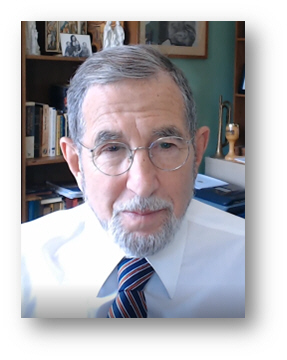
“Where do We Go From Here?”
When Pope Francis Abolishes the Latin
Mass
For the text version of this video, click
here
|
|
Please visit us at our new
 channel
channel
|
Comments? Write us:
editor@boston-catholic-journal.com
The Holy Catholic Faith
Where is it And Who is Keeping
it?
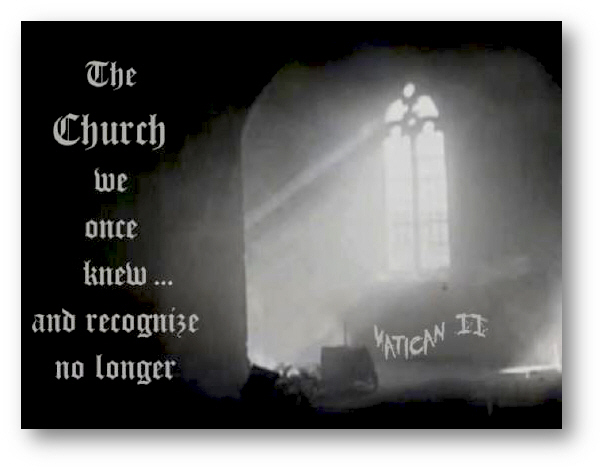
Has the
Post-Conciliar Church
Lost Custody of the Faith?
All indications are that is has.
The “Dark
Ages” — that disdainful term for the period in history following
the collapse of the Roman Empire in 476 A.D. until the 15th
century (a period correctly described as the Middle
Ages) is understood by the secular world to have
lasted roughly 1000 years, beginning in Florence, Italy.
Within the
post-Conciliar Catholic Church, however, it appears
that the term extends well beyond the 15th century;
indeed, some 500 years beyond it! According to contemporary
Catholic thought articulated within the past five papacies,
the “Dark Ages” really ended in 1965 at the conclusion
of the Second Vatican Council. All the doctrines and teachings
prior to that Council were only imperfectly, deficiently,
and insufficiently articulated or defectively understood.
The 1000
Years of Darkness
Only
the Second Vatican Council finally attained to enlightenment
in the divine economy, and after 1,965 years of suspension,
it alone has provided the final, sufficient, and correct
understanding of God and Church, man and nature. Prior to
that, according to post-Conciliar thought, Catholics had
essentially lived in darkness, specifically the darkness
of the “pre-Conciliar Dark Ages.” It may be said that where
the Rational Enlightenment “saved the world from religion,”
Vatican II saved the Church from Catholicism.
Continue reading
Martyrology for Today
Semen est sanguis Christianorum (The blood of Christians
is the seed of the Church) Tertullian, Apologeticum,
50
ROMAN MARTYROLOGY

Saturday,
April 26th
in
the Year of Grace 2025
Easter
Saturday
This Day, the Twenty-Sixth Day of April
At Rome, the birthday of blessed Cletus,
Pope who governed the Church the second after the
Apostle St. Peter, and was crowned with martyrdom in the
persecution of Domitian.
In the same city, in the time of Maximian,
St. Marcellinus, Pope and martyr,
who was beheaded for the faith of Christ,
with Claudius, Cyrinus, and Antoninus.
So great was the persecution at this time that
within a month
seventeen thousand Christians
were crowned with martyrdom.
At Amasea, in Pontus, St. Basileus,
bishop and martyr, whose illustrious martyrdom occurred
under the emperor Licinius. His body was thrown into the
sea; but being found by Elpidiphorus, through the revelation
of an angel, it was honorably entombed.
At Braga, in Portugal, St. Peter,
martyr, the first bishop of that city.
At Venice, St. Clarence, bishop and
confessor.
At Verona, St. Lucidius, bishop.
In the monastery of Centula, St. Richarius,
priest and confessor.
At Troyes, St. Exuperantia, virgin.
And elsewhere in divers places, many other holy martyrs,
confessors, and holy virgins.
Omnes sancti
Mártyres, oráte pro nobis.
(“All
ye Holy Martyrs, pray for us,” from the Litaniae Sanctorum, the Litany
of the Saints)
Response: Thanks be to God.
|
Roman Martyrology by Month
Why the Martyrs Matter
Each day we bring you a calendar,
a list really, of the holy Martyrs who had suffered and died
for Christ, for His Bride the Church, and for our holy Catholic
Faith; men and women for whom — and well they knew — their
Profession of Faith would cost them their lives.
They could have repudiated all three (Christ, Church, and Catholic
Faith) and kept their lives for a short time longer (even the
lapsi * only postponed their death — and
at so great a cost!)
What would motivate men, women, even children and entire families
to willingly undergo the most evil and painfully devised tortures;
to suffer death rather than denial?
Why did they not renounce their Catholic Faith when the first
flame licked at their feet, after the first eye was plucked
out, or after they were “baptized” in mockery by boiling water
or molten lead poured over their heads? Why did they not flee
to offer incense to the pagan gods since such a ritual concession
would be merely perfunctory, having been done, after all, under
duress, exacted by the compulsion of the state? What is a little
burned incense and a few words uttered without conviction, compared
to your own life and the lives of those you love? Surely God
knows that you are merely placating the state with empty gestures
…
Did they love their wives, husbands, children — their mothers,
fathers and friends less than we do? Did they value their own
lives less? Were they less sensitive to pain than we are? In
a word, what did they possess that we do not?
Nothing. They possessed what we ourselves are given in the Sacrament
of Confirmation — but cleaved to it in far greater measure than
we do: Faith and faithfulness; fortitude and valor, uncompromising
belief in the invincible reality of God, of life eternal in
Him for the faithful, of damnation everlasting apart from Him
for the unfaithful; of the ephemerality of this passing world
and all within it, and lives lived in total accord with that
adamant belief.
We are the Martyrs to come! What made them so will make us
so. What they suffered we will suffer. What they died for, we
will die for. If only we will! For most us, life will be
a bloodless martyrdom, a suffering for Christ, for the sake
of Christ, for the sake of the Church in a thousand ways outside
the arena. The road to Heaven is lined on both sides with Crosses,
and upon the Crosses people, people who suffered unknown to
the world, but known to God. Catholics living in partibus
infidelium, under the scourge of Islam. Loveless marriages.
Injustices on all sides. Poverty. Illness. Old age. Dependency.
They are the cruciform! Those whose lives became Crosses because
they would not flee God, the Church, the call to, the
demand for, holiness in the most ordinary things of life made
extraordinary through the grace of God. The Martyrology we celebrate
each day is just a vignette, a small, immeasurably small, sampling
of the martyrdom that has been the lives of countless men and
women whom Christ and the Angels know, but whom the world does
not know.
“Exemplum enim dedi vobis”, Christ
said to His Apostles: “I have given you an example.” And His
Martyrs give one to us — and that is why the Martyrs matter.
-
A Martyr is one who suffers
tortures and a violent death for the sake of Christ
and the Catholic Faith.
-
A Confessor is one who
confesses Christ publicly in times of persecution and who
suffers torture, or severe punishment by secular authorities
as a consequence. It is a title given only given
to those who suffered for the Faith —
but was not killed for it — and
who had persevered in the Faith until the end.
Geoffrey K. Mondello
Editor
editor@boston-catholic-journal.com
Boston Catholic Journal
Note: We suggest that you explore
our newly edited and revised
“De
SS. Martyrum Cruciatibus — The Torments and Tortures of the
Christian Martyrs”
for an in-depth historical account of the sufferings of the
Martyrs.
*
Those early Christians who renounced their Catholic Faith
in times of persecution. When confronted with the prospect
of torture and death if they held fast to their faith in
Christ, they denied Him and their Faith through an act of
sacrificing (often incense) to the pagan Roman gods and
in so doing kept their lives and/or their freedom and property.

Totally Faithful to
the Sacred Deposit of Faith entrusted
to the Holy See in Rome
“Scio
opera tua ... quia modicum habes virtutem, et servasti
verbum Meum, nec non negasti Nomen Meum”
“I
know your works ... that you have but little power,
and yet you have kept My word, and have not denied
My Name.”
(Apocalypse 3.8)
Copyright © 2004 - 2025 Boston Catholic
Journal. All rights reserved. Unless otherwise stated,
permission is granted by the Boston Catholic Journal
for the copying and distribution of the articles
and audio files under the following conditions:
No additions, deletions, or changes are to be made
to the text or audio files in any way, and the copies
may not be sold for a profit. In the reproduction,
in any format of any image, graphic, text, or audio
file, attribution must be given to the Boston Catholic
Journal.
|
|
